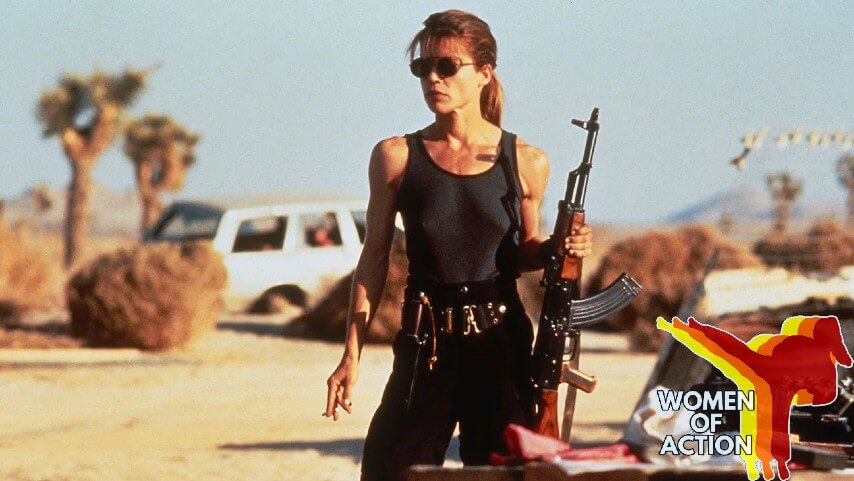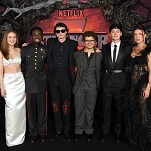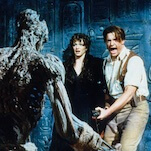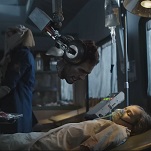With Women Of Action, Caroline Siede digs into the history of women-driven action movies to explore what these stories say about gender and how depictions of female action heroes have evolved over time.
After The A.V. Club said yes to my pitch for a column about women-led action movies, I immediately whipped out my Notes app to brainstorm a quick chronology of female action heroes. Like any good former history major, I first thought of the women-movement steeped 1970s as a natural starting place, what with badass Blaxploitation heroines and resilient horror movie final girls taking over the silver screen while Charlie’s Angels and Wonder Woman aired on primetime TV. But, of course, Wonder Woman first made her comic book debut way back in the 1940s, and before that silent films had their own world-famous stuntwomen while folk heroes like Calamity Jane and Annie Oakley were drawing crowds even earlier.
From the warrior goddesses of Ancient Egypt to Joan of Arc herself, there has never been a time in human history when images of powerful women didn’t exist in the public consciousness—a fact that’s worth remembering lest we perpetually reset the starting line with each new generation. But when it comes to female-led action movies as we know them today, there are two women who serve as the definitive godmothers of the genre: Ellen Ripley (Sigourney Weaver) in the Alien franchise and Sarah Connor (Linda Hamilton) in The Terminator franchise. And while there’s probably a case to be made that this column should’ve started with Ripley, who debuted five years before Sarah, I’m too much of a Terminator obsessive not to start there. (Much like the Planet Of The Apes series, I maintain that even a bad Terminator movie is still more entertaining than 90% of blockbusters out there.)
My love for Terminator is especially strong because I came to the franchise later than most kids of the ’90s. Maybe it was the R-rating or the pre-teen John Connor of it all, but there was something about Terminator that didn’t feel like it was for me, even growing up as a sci-fi loving little girl. Arnold Schwarzenegger so subsumes the franchise’s cultural footprint that I’m honestly not even sure I realized the first film starred a female lead until I finally sat down to binge the entire franchise in the lead up to Terminator Genisys in 2015. My only vague cultural impression at that point was that 1984’s The Terminator was the messy first draft you had to sit through to get to the good stuff in T2. Instead, I found a movie—and a character—I fell in love with almost immediately.
What makes original flavor Sarah Connor such a great sci-fi action heroine is that she in no way feels like the sort of person who should be a sci-fi action heroine. Unlike Weaver, who’s 6’0” and exudes a natural sense of authority, Hamilton is just 5’5” with a breathy voice and a playful sense of humor. While the original Terminator gives Sarah some fun character quirks (She owns a pet iguana! She takes herself out for pizza when her date cancels on her!), she’s first and foremost a relatable everywoman—the Marty McFly of chill but slightly frazzled L.A. waitresses.
Though Alien and The Terminator are both horror-fused sci-fi films that only really become true action blockbusters in their sequels, Sarah Connor exists far more in the classic “final girl” mold than Ripley ever did. She doesn’t know about interstellar quarantine regulations or chains of command, she can’t even balance her checkbook! So when a deranged-looking man shows up to tell her she’s the future mother of humanity’s last chance at survival, she reacts like any of us might to that news: with distrust, bewilderment, and an instinctual drive to survive.
Indeed, while the stereotypical male-driven action movie is a wish-fulfillment power fantasy (What if you could be Indiana Jones or James Bond?!?), female-led action movies are more often than not stories of persecution and survival. Despite its high-concept sci-fi premise, Terminator immediately anchors itself in the very relatable real-world fears that many women think about on a daily basis: the fear of being stalked, of being murdered, of not being able to tell a good guy from one who wants to hurt you—even the fear of accidentally getting pregnant and what that will mean for your future.
Of course, that doesn’t mean there’s not a wish fulfillment element to female-led action movies as well, and I’m not just talking about Hamilton’s impeccably toned arms in T2 (we’ll get to those in a minute). For as much as “weaponized incompetence” has become a buzzword for men, I think there can also be a kind of “learned helplessness” ingrained in young women too; a sense that if things become too hard you can always just give up and ask a man to carry a box or change a tire or be the one who runs into danger for you. The thrill of the first Terminator comes from watching a young woman face the worst things imaginable and learn that she is strong enough to survive on her own.
Crucially, it’s a message that unfolds not in ham-fisted dialogue, but in how co-writer/director James Cameron stages his action scenes. You can quite literally track Sarah’s arc via the film’s three big car chases. In the first, she’s completely at the mercy of time traveler Kyle Reese (Michael Biehn), who pulls her out of the Terminator’s crosshairs with his iconic line, “Come with me if you want to live.” In the second, she just about manages to hold it together when Kyle tells her to take the wheel—even pulling a clever move with a parking brake while he’s busy firing rounds at the Terminator. By the final car chase, she’s casually handing Kyle grenades and seamlessly trading places with him while they barrel down the highway. Where Kyle was once the one pulling Sarah out of danger, she’s now the one dragging him to safety with a guttural, “On your feet, soldier!”—a line that Hamilton herself said unlocked a well of strength she didn’t know she had.
Though I’m not sure I can ever call the man who directed True Lies a bastion of feminism, I appreciate that Cameron handles Sarah and Kyle’s romance with the same sort of quietly subversive touch he’d go on to use to such great effect in Titanic. Kyle is squirrelly, sensitive, and inexperienced at intimacy, where Sarah is playful, pragmatic, and impressively able to hold her shit together—right on through to an effectively eerie epilogue that sees her driving off to become the mentor to humanity’s savior. While I’ve read some thoughtful feminist critiques that are wary of the way Terminator’s time travel set-up reduces Sarah to a “walking womb,” I’ve always seen her pregnancy as part of the franchise’s broader exploration of fate and free will, rather than a means of tying the female experience solely to motherhood. Terminator was co-written and produced by Gale Anne Hurd, and championed by two female executives at Orion Pictures who were all “interested in having a female character who was active, not simply somebody’s girlfriend.”
Yet despite all the cool ideas packed into the first film, Sarah Connor wasn’t really thought of as a true action heroine until she got a buff movie makeover seven years later in Terminator 2: Judgment Day. Just weeks after giving birth to her first child, Hamilton began a months-long fitness regimen that included weight lifting, fat loss, and intensive weapons and military training with a former Israeli special forces soldier. Watching Hamilton’s sinewy arms lift her into frame in T2 is as impressive a physical transformation as anyone has ever delivered in cinema history, and has long earned her praise for being a “badass” or an “icon” for strong female characters. But, as in the first film, Sarah’s arc is far more complicated than just beat-‘em-up wish fulfillment.
In fact, when Cameron (fresh off giving Ripley a mech suit in 1986’s Aliens) called up Hamilton to see if she’d be interested in coming back for a Terminator sequel, she had one request: “I want to be crazy.” Hamilton instinctively knew there was no way Sarah could experience everything she did in the first film and not come away utterly changed by shell shock, grief (her best friend and her mother are both murdered by the Terminator), and the weight of knowing humanity’s end date. Terminator 2 needed to have an emotional continuity as airtight as the franchise’s clever closed-loop time travel. And what pop culture celebrations of Sarah’s badass makeover sometimes miss is that she’s not really an aspirational portrait of strength so much as a woman who’s spent 10 years existing in a non-stop trauma response. As Hamilton put it, “Sarah Connor is not an icon. She’s a woman in hell.”
Much like the first film, T2 anchors Sarah’s arc in fears that are relatable to everyday women: the fear of not being believed, of being institutionalized, of being sexually harassed by men who have power over you, of not being able to protect your child, of letting existential fears strip you of your humanity. If the first Terminator challenges the fallacy of learned helplessness, T2 explores another unhealthy coping mechanism so many women rely on: hyper-independence. Faced with the knowledge that the future of humanity rests on her ability to protect and train her son, Sarah has closed herself off from emotional vulnerability, even though, ironically, that’s the very thing her kid wants most from her. “I didn’t need your help,” she coldly tells John (Edward Furlong). “I can take care of myself.”
Except that’s only true up to a point. Sarah’s escape from the psychiatric ward is one of the best, most exhilarating sequences in T2—one that proves she’s more powerful with a single paperclip than an entire hospital full of security guards. But what stands out even more is how Hamilton plays the moment Sarah sees Schwarzenegger’s T-800 round the corner for the first time since her night of terror back in 1984. Despite the fact that getting back to John has been Sarah’s sole motivation up to that point, her trauma response to seeing her tormentor again takes over her maternal instinct. She ignores her son’s calls and breaks down with the sort of hysterical primal fear she thought she’d been able to weight train out of herself. It’s a moment of “weakness” that’s also one of the strongest character beats in the movie.
While the classic reading of T2 is that it’s about the T-800 becoming human while Sarah Connor struggles not to become a Terminator, she’s even more of a parallel for Kyle Reese: war-torn, mission-driven, callous but full of more humanity than she wants to admit. The later shot of Sarah in sunglasses and a tight blank tank top has become perhaps the single most defining image of her “badassery.” But it actually comes after Sarah’s warm reunion with some old paramilitary friends proves she hasn’t totally lost her softer side after all—the first sign that she won’t be able to go through with her mission to kill Skynet’s future creator, Miles Dyson (Joe Morton).
Pretty much every scene Sarah gets in T2 is great and, if forced to choose, I do think it’s an overall stronger movie than the first Terminator (although it’s close). But it’s also worth pointing out that after Sarah decides not to kill Dyson, she doesn’t actually get a ton to do for the rest of the movie. Schwarzenegger had become too big of a star not to get the ultimate hero’s journey in this supersized sequel. And in stepping into Kyle’s arc, Sarah also inherits his role as someone who’s secondary to the plot—no matter how cool it is to watch her pump that shotgun with one arm. (Hamilton was also paid just $1 million for the project, while Schwarzenegger made closer to $15 million.)
It’s more than a little ironic that the movie that gives Sarah the iconography of an action heroine is the one where she isn’t actually the lead, while the movie that sometimes gets dismissed as a “damsel in distress story” is the one where she is. Despite how long powerful women have been a part of culture, we can sometimes still struggle to see them for what they are because our conceptions of strength are so tied up in the trappings of masculinity. That makes Sarah Connor both a trailblazer for modern female action heroes and a fascinating case study in what it means to be a female action hero.
The character would return played by Lena Headey in the 2008 TV show The Sarah Connor Chronicles, Emilia Clarke in 2015’s Terminator Genisys, and once again by Hamilton in 2019’s Terminator: Dark Fate (all properties I’d love to cover in this column one day). But it’s her role in the first two films that’s left the greatest cultural legacy. Sarah more than earned her place in the pantheon of great action heroes, and not just because of her survival skills or ripped physique. In between Terminator’s larger themes about taking charge of your fate and learning to evolve, Sarah Connor had her own messages to pass on as well: you’re stronger than you think you are, but no man (or woman) is an island.
Next time: I’ll get around to Ripley and the Alien franchise one day, but for now we’re moving out of genre territory and into the real world with Jennifer Lopez in Enough.








































